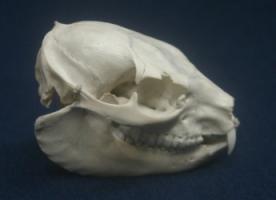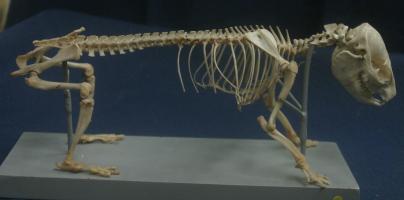ORDER HYRACOIDEA: THE
HYRAXES.
Three modern genera: eleven species. All in Family
Procaviidae.
Hyraxes possess:
- Unspecialised, plantigrade feet.
- Toes - united by a pad and ending in hoof-like
nails.
- 4 toes on fore foot, 3 on hind foot.
- Poor thermoregulation.
- Complex gut - microbial digestion sites for
breaking down fibrous material.
The Hyracoidea was once a very diverse group
including lion-sized forms and some semi-aquatic genera, almost
exclusively African.
 |  |
| Rock hyrax skull | Rock hyrax skeleton |
The most notable modern hyrax is the rock hyrax
(Procavia capensis),
which feeds mostly on coarse grass. Besides
Procavia, the other
two genera are
Dendrohyrax, the 'tree
hyraxes' and
Heterohyrax, the 'bush
hyraxes'.
Curiously, two species of hyrax
(P.johnstoni and H.brucei
) live in mixed groups, sharing sleeping
holes, latrines and nursery groups but not interbreeding. Competition
is avoided by their having different diets.
|
